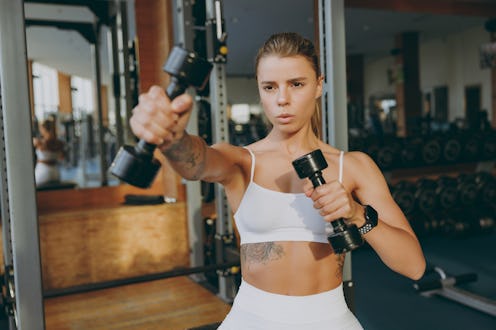Fitness
The Secret To Breathing Properly During Your Workouts
This will help you get the most out of your sweat sessions.

The next time you do a bicep curl, lower into a squat, or jog on the treadmill, try to pay attention to the way you breathe. If you naturally fall into a pattern where you hold your breath or take short gasps of air, you’ll definitely benefit from making a few changes to ensure you’re breathing properly during exercise.
Of course, exercising is supposed to challenge your breathing. As you move, your lungs work harder to bring in oxygen and remove carbon dioxide while your heart pumps faster to circulate oxygen to whatever muscles you’re using. As all of this happens, your breathing increases from an average of 15 times a minute at rest to 40-60 times a minute during exercise. But there are ways to get a better handle on this demand. According to Dr. Robert W. Berghorn, Jr., DPT, ATC, USAW, a doctor of physical therapy and owner of Ascent Physical Therapy, practicing breath control during a workout has two benefits. “It allows you to get adequate blood supply to your brain in regular intervals, and it also provides a greater level of support and stability throughout your body and core muscles,” he tells Bustle.
Getting enough oxygen to your brain and muscles means you’ll be able to perform better for longer, Berghorn says, especially compared to when you don’t take full inhales and exhales. A proper breath can also help your core muscles support you. “The diaphragm, which allows you to breathe, is a muscle and is one component of your core musculature,” Berghorn explains. “By inhaling you are creating pressure within your abdominal cavity that — along with your hips, abdominal, and spinal muscles — provides great support and stability so you can move safely and with maximum effectiveness.”
If you’re not breathing properly when doing cardio or strength training, you won’t be able to make the most out of your workout, says Joey Thurman, CES, CPT, FNS, a celeb trainer with fitness platform kuudose. Not only that, but shallow, uneven breaths can make you feel dizzy or lightheaded due to hyperventilation, he says. To avoid that, read on for tips on how to efficiently breathe during exercise.
How To Breathe When Strength Training
If you tend to hold your breath while lifting weights or doing strength work, listen up. The rule of thumb is to exhale as you lift a weight and inhale as you lower it back down, Thurman says. It’s all in the name of getting the most oxygenated bang for your buck. Fun fact: That’s why you always see seasoned weightlifters exhaling with purpose as they power through a move.
There is a level of coordination that comes with this type of purposeful breathing, Berghorn notes, but once you get the hang of it you can apply it to all sorts of exercises. “Let's take a squat for example,” he says. “You’ll want to take a deep inhale on the way down, being at max inhale at the bottom of the squat. From there, you’ll breathe out as you push into the ground to stand up.”
Pursing your lips as you breathe out is also key. “Breathing out of your mouth through pursed lips allows you to better retain oxygen in your lungs, allowing a greater amount of oxygen transfer to your body and muscles for better function with each breath,” Berghorn explains. It may feel like overkill, but it’s definitely worth it.
How To Breathe During Cardio
You should also make sure that you’re breathing in and out as fully as possible as you run, row, or glide on an elliptical. For cardio, Thurman recommends breathing in deeply through your nose and out through your mouth. “This helps to warm and moisten the air going into your lungs,” he says, which makes for a more comfortable workout.
Keep a comfortable pattern going as best you can, making sure to purse your lips for that sweet, sweet oxygen transfer. You might eventually switch to breathing in and out through your mouth as your routine becomes more intense, and that’s OK. If you start to breathe in through your mouth, Berghorn recommends maintaining control of your respiratory rate by making it as steady and measured as possible.
If you feel tired, lightheaded, or dizzy during your workout, it may mean you’re breathing too fast or too slow. If so, take a break and get back to a steady breathing pattern, and then see how you feel. As Thurman says, “By following these simple tips, you can make sure you're getting the most out of your workout and avoid any potential health risks.”
Studies referenced:
Bahenský, P. (2021). Impact of a Breathing Intervention on Engagement of Abdominal, Thoracic, and Subclavian Musculature during Exercise, a Randomized Trial. J Clin Med. doi: 10.3390/jcm10163514.
Querido, JS. (2007). Regulation of cerebral blood flow during exercise. Sports Med. doi: 10.2165/00007256-200737090-00002.
Sakhaei, S. (2018). The Impact of Pursed-lips Breathing Maneuver on Cardiac, Respiratory, and Oxygenation Parameters in COPD Patients. Open Access Maced J Med Sci. doi: 10.3889/oamjms.2018.407.
Your lungs and exercise. Breathe (Sheff). 2016 Mar;12(1):97-100. doi: 10.1183/20734735.ELF121. PMID: 27066145; PMCID: PMC4818249.
Sources:
Joey Thurman, CES CPT FNS, celeb trainer with kuudose
Dr. Robert W. Berghorn, Jr., DPT, ATC, USAW, doctor of physical therapy owner of Ascent Physical Therapy
This article was originally published on